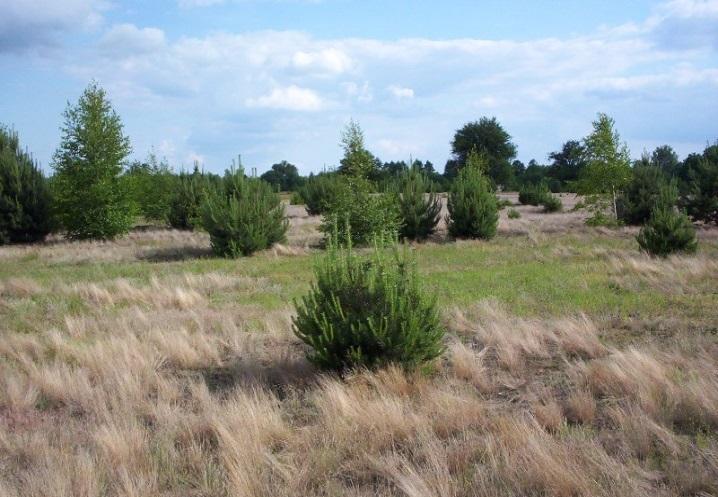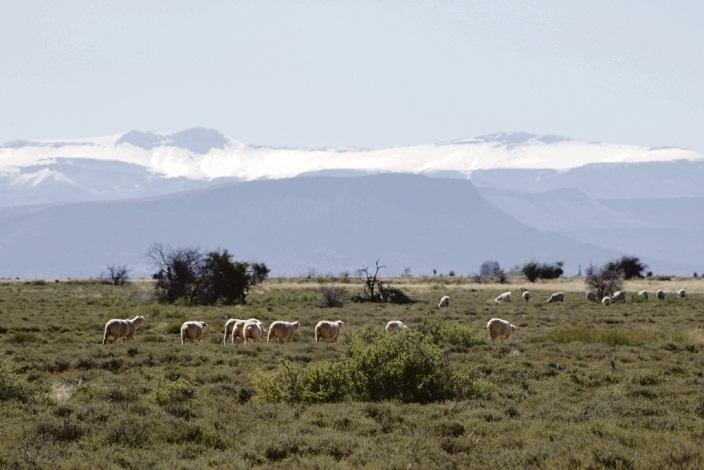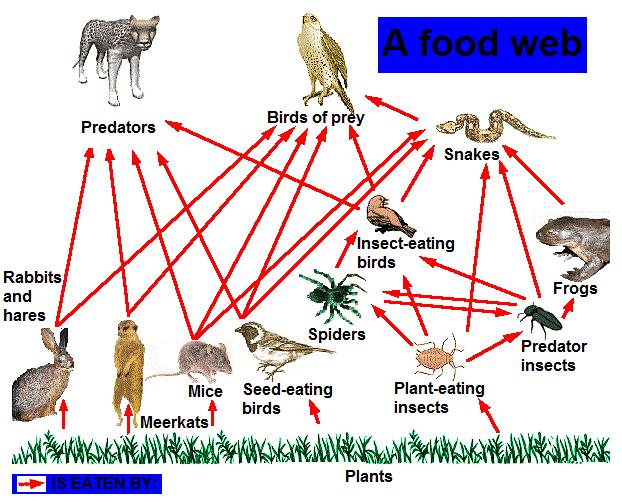Lesson 1: Ecology and agri-ecology
Biotic factors
What is meant by the concept ‘biotic factors’?
These factors entail all the interactions that occur between various organisms in a specific habitat. These influences may be direct or indirect.
Examples
Direct influences
• Seed distribution
• Competition
• Grazing
Indirect influences
• Humus formation
• Fertilisation
• Shade provision
Plants
Under plants, we study the following:
• Vegetation structure
• Community composition
• Competition
• Symbiosis
Vegetation structure
The habitat as well as other organisms in the environment are affected by the vegetation structure of plants. Plants grow in the soil and when they die, their remains return to the soil. As the decaying remains become intermixed with the soil, it becomes part of the soil. This influences fertility, water capacity and temperature of soil.
• Tree roots grow deep and break down rocks in the soil.
• Plants keep the soil in one place and prevent soil erosion.
• Fast and lush-growing plants such as weeds and grass eliminate other plants.
Little sunlight reaches the soil beneath a tree, as trees’ leaves are spread in such a way that each leaf is exposed to sufficient sunlight. It is therefore the reason why few plants grow beneath trees. In a forest, the temperature and humidity are more constant and there is a low light intensity. In open areas, plants grow prolifically as sunlight is not cut off through tree leaves. Different types of animals are found in certain areas based on their nutritional needs.
IMPORTANT:
Only sciophytes grow underneath trees. The distribution of animals are closely related to the vegetation structure and not the species composition.
Composition of the community
Some plants in a community are more significant than others in determining the nature and function of the entire community. Only individual species or groups of species dominate based on their numbers, size, production or other activities.
Study the following example
If a dominant, for example a tree type, is removed, it has significant changes in effect. The changes do not only occur in the biotic community, but also in the physical environment, namely the micro-climate. When a non-dominant grass specie is removed, little change will be brought about
IMPORTANT:
In general, the dominant is a specie that possesses the highest productivity in a community.
Competition
Competition may exist between members of the same specie (intra-specific) or between two or more species (inter-specific).
Where does intra-specific competition occur?
Intra-specific competition usually occurs around water and light.
Study the following example
As the density increases as a result of growth, the numbers decrease, as some of the plants die off as a result of competition. It is a well-known phenomenon with crops like beetroot and carrots. The shape of a tree is a result of competition for light.
Why? Since it may give rise to branches dying and being shed where leaves receive insufficient sunlight. Competition is responsible for the development of various types of morphological and ecological adaptations that enable two species to utilise the habitat in different ways. Succulents are good examples.
What happens when competition occurs?
The most specialised specie survives and consequently replaces the other species.
Factors that promote competition
• Droughts
• Over-grazing
• Soil erosion
Competition is promoted under these circumstances, as a dramatic change in the vegetation occurs. A good example is the expansion of Karoo vegetation at the cost of sweet grassland.
Inter-specific competition may cause an adaptation to a state of equilibrium between two competing species, or it may lead to the replacement of one specie in the community by another. There are two examples, respectively:
DEFINE:
State of equilibrium: Red grass and finger grass coexisting. Replacement of a specie: Weeds in a field.
Under symbiosis, there is a range of interactions. Competition occurs when two plants utilises the same source in short supply, e.g. food, water, light, air and cover, resulting in the growth and survival of these plants to be negatively affected.
Competition: a mechanism of natural selection and evolution where one specie dominates the other.
Symbiosis: the living together of two organisms of different kinds. They may not have any effect on each other, or they may affect each other positively or negatively.
Neutralism: The two species do not affect each other.
Mutualism: neither of the two species can survive, grow or procreate in the absence of the other specie. An example would be the nitrogen-fixing bacteria in the roots of legumes.
Cooperation: both species form a non-essential partnership that is beneficial to both. An example is the ant and the aphid.
Commensalism: only one specie benefits, for example epiphytes that grow high up in trees.
Amensalism: the growth and procreation of one specie is suppressed. A good example is Penicillium that secretes penicillin that hinders the growth of bacteria.
Parasitism: a parasite is exclusively dependent on its host for food. Here we look at examples like the Striga (red flower) and Cuscuta (dodder) that need other plants to feed.
Predatism: one specie (predator) kills another specie (prey) in order to feed. Insectti lt d l
Animals
Animals are just like plants, very important to the balance of an ecosystem and plays an important role in the ecological succession. There are animals just like plants that live in extremely limited areas and in close relation to each other and certain plants. Predators that need to get their energy from eating plant-eaters or even other predators are consumers of the second or even the third order.
Based on their feeding method, animals are divided into
• Herbivores
• Carnivores
• Omnivores
IMPORTANT TERMINOLOGY: Sample
Plants are ‘energy fixers’, as they serve as food for all living creatures, whether directly or indirectly Animals that are dependent on plants for food are called consumers.
Herbivores are plant-eaters. Carnivores are meat-eaters. Omnivores are opportunistic eaters. Herbivores are known as primary consumers
Herbivores
What do herbivores feed upon?
Herbivores feed upon plant matter that varies from bacteria, algae, grasses, shrubs, to trees. It includes all ruminants, like antelope, large and small livestock, as well as some bird species, snails and most insects. Only herbivores are adapted to feed on a cellulose-rich diet, as the digestive process in ruminants depend on bacterial fermentation in the rumen. Through the continual grazing by herbivores, plants may eventually become extinct, as these animals mainly feed on the leaves, fruit and seed of these leaves. Leaves and seeds may be rejuvenated and grow, and may even be stimulated if grazing is ceased.
What is the consequence of leaf loss in plants?
The loss of leaves reduces the vitality, competitiveness and reproductive ability of plants. (Reproductive ability is reduced, since the formation of seed is delayed). The trampling of pasture goes hand in hand with this. When selective grazing occurs, palatable plants are over-grazed and eventually destroyed, which causes an increase of less palatable plants. To eliminate these problems, peak grazing is applied where large and small livestock graze a camp simultaneously. Goats often damage the growth tips of young trees and shrubs. Consequently the plants will die.
What are the disadvantages of overgrazing?
Pioneer plants may increase and exposure may even cause erosion of the soil.
Carnivores
Lions and jackals are examples of carnivores. These animals feed on herbivores and even each other. Scavengers feed on dead animals, and predators are carnivores that hunt their prey. Cannibalism is an uncommon form of predatism that occurs within a specie. Cannibalism occurs with chicks.
What is the advantage of cannibalism?
It plays an important role in the control of the number of herbivores as well as the effects of overgrazing and trampling of the vegetation.
What determines the numbers of predators?
The availability and number of prey.
Omnivores
To define omnivores, we can say: Omnivores are an intermediate phase between herbivores and carnivores. They are thus opportunistic feeders, in other words, they feed on the available food. Examples of omnivores are birds, fish, some protozoa, humans and pigs.
Let us now look at six other significant effects of animals on the ecosystem
• Bees, moths and beetles aid in the pollination of plants.
• Animals aid in the distribution of seeds and fruit and thus the establishment of plants.
• Earthworms aid in the aeration of soil.
• Animals aid in the fertilisation of soil, thus increasing the soil fertility.
• It causes some plant pests and diseases and the spread of plant diseases from one plant to the next.
Mutual relations
Termites are brought to mind. Why? Termites carry protozoa or bacteria, depending on the specific specie. These microorganisms aid in the digestion of cellulose, while the termite offers a suitable habitat to the micro-organism within its intestines.
Human
In earlier times, humans lived in small groups and only had a few implements at their disposal. Humans were part of the local ecosystem and their influence was insignificant. As civilisation became more sophisticated, humans’ effect on the environment increased drastically. As humans are in competition with a large number of other humans, the entire ecosystem can be changed. Humans destroy not only existing habitats, but creates new habitats through their drive to increased production to feed a fast-growing population.
Abiotic factors
FOR THE CURIOUS:
In the southern hemisphere, air circulation between high and low-pressure zones occurs in an opposite direction than the circulation in the northern hemisphere. Flora, in the Roman mythology, is the goddess of flowers. The word is taken from the Latin word flos, meaning flower. Fauna comes from the Latin faunus. Although the difference is not always very clear, an ecological distinction is made between abiotic (non-living) and biotic (living) factors. Let us look at an example:
Temperature is regarded as an abiotic factor and is often changed by the presence of living organisms.
Abiotic or non-living factors
These factors entail the physical environment where the biotic community occurs and include the following three factors: physiographical, climatic and soil factors. In various environments, these factors are not equally important.
Physiographic factors
What is affected by the topography of a specific area?
Light, temperature and humidity conditions. With an increase in height above sea-level it does not only become colder, but northern slopes in the southern hemisphere are warmer and drier, resulting in more light that is more suited for xerophytic plants.
Why? The sun’s rays virtually form a right angle with the earth’s surface.
Two groups of plants are discerned
Sun plants (heliophytes) on northern slopes and shade plants (sciophytes) on southern slopes.
Why are valleys usually more humid than slopes?
The intensity of water run-off against slopes are higher and water infiltration poor. Climatic extremes occur in valleys. Nights are much colder (especially in winter) and the days are much warmer (particularly in summer). A high humidity with periodic fog occurs when the air in the valley comes into contact with cold air that flows in.
An increase in ultra-violet radiation is experienced with an increase in height above sea level. On high grounds, the climate is harsher Therefore, the selection of organisms with a higher tolerance for the physical environment, having more general feeding habits, is promoted.
A region’s climate is its characteristic weather over a prolonged period. Rainwater is ultimately the source of all water on earth.
Living organisms can only survive between 0 °C and 50 °C.
IMPORTANT:Sample
Light is ultimately the source of all energy.
Wind is air that moves from one place to another.
Wind always blows from a high-pressure area to a low-pressure area
Difference in vegetation between slopes with changes in altitude.
Climatic factors
Factors that influence climate over a period are temperature, humidity, precipitation of rain, solar radiation, winds, atmospheric pressure and other weather conditions. We are only required to discuss the following factors: precipitation, temperature, wind and light.
Precipitation
Since animal protoplasm consists of between 70% and 90% water, it is absolutely essential for life.
Precipitation is important for the survival of all plants and animals, as rain is ultimately the source of all water on earth. The flora and fauna (plant and animal populations) that occur in a specific area are often determined by the ration between precipitation and evaporation, rather than rainfall only.
Let us look at an example
Two areas receive equal precipitation annually, but different types of plant occur in these areas.
The rate of evaporation is not the same, as well as the fact that seasonal distribution and intensity of the rain may differ. Therefore, based on the ratio, distribution and intensity of precipitation a specific area may be a grassland, a desert or a forest. Wind and temperature have a significant effect on evaporation, as well as the relative humidity of a specific area.
Temperature
Living organisms can only survive in temperatures between 0 °C and 50 °C, as normal metabolic activities can only occur within this temperature range. A specific temperature exists for each specie, that may vary significantly, which in turn depends on its stage of development. It is important to be acquainted with the temperature needs of a specie. A determining factor for the survival of a specie in a specific area is the difference in temperatures that appear from time to time in the specific area, or even over a short term.
Temperature plays an important role with regards to the control of seasonal activities of certain organisms. The following are examples: stone fruit, some bulbs like onions, tulips and some grains need a cold period for optimal growth and development.
Sheep farming in the dry Karoo.
TIP:
CORE CONTENT:
Water moves in a never-ending cycle. The heat from the sun causes water from the sea, rivers and dams to evaporate. As it rises in the atmosphere, the vapour cools down and condensates as clouds. Eventually these droplets fall down to earth again as rain.
Wind
What effects does wind have on the environment?
At first, the effect is indirect. This means that the temperature may rise or fall due to the circumstances. Wind affects soil moisture and humidity, as the wind tends to increase the rate of evaporation and transpiration. This effect of wind may give rise to forest fires and local droughts. In areas where heavy winds occur, limited vegetation will be found.
The result: The fauna will be fully or partially eliminated. Winds may also be advantageous, as it is needed for the distribution of seeds and even small animals. It plays an important role in pollination. The high rate of evaporation of the wind may cause the soil areas with low rainfall to become brackish. Wind may also cause erosion, particularly in the western parts of South Africa
Light
We know that light is the source of all energy. All life is directly or indirectly dependent on light, but protoplasm may be damaged by excessive light. Ecologically speaking, the duration, intensity and quality of light all play important roles. Intensity and quality may vary significantly with local conditions. Daylight length, or the duration of the light period, has an important effect on the vegetation. The angle of the sun’s rays on the earth’s surface is important as it plays a role in the warming effect that the sunrays have on the earth.
Ecosystems are influenced by light in two ways
• Light affects photosynthesis.
• Light affects the daily and seasonal patterns in activity of plants and animals.
This means that, besides the fact that all green plants need light to grow by the process of photosynthesis, light also plays a role in the phenomenon known as photoperiodicity, phototropism and photo axis.
Soil factors (edaphic factors)
Soil is the outer layer of the earth’s crust in which plants grow.
Soil consists of
• Rock particles
• Organic matter
• Air
• Water
• Living organisms
The important factors to consider for plant and root growth are
• Soil types: clay, sand and loam soil
• Soil texture: coarse soil that is influenced by particle size.
• Soil depth: the depth to which roots can penetrate the soil.
• Soil water: the availability of water in the soil
• Soil fertility: the availability of mineral nutrients in the soil.
IMPORTANT TERMINOLOGY:
Sustainable: something that has to be kept going continuously Poikilothermic: cold-blooded ACTIVITY 1
1. Give a clear description of ecology and the environment.
2. Name three factors that promote competition.
3. Define: 3.1 Symbiosis
3.2 Mutualism
3.3 Amensalism
3.4 Parasitism
4. Discuss leaf loss in plants. (8)
5. What is affected by the topography of a specific area? (7)
6. In which two ways are ecosystems influenced by light?
7. Name the most important factors to consider for plant and root growth.
(6)
(3)


























